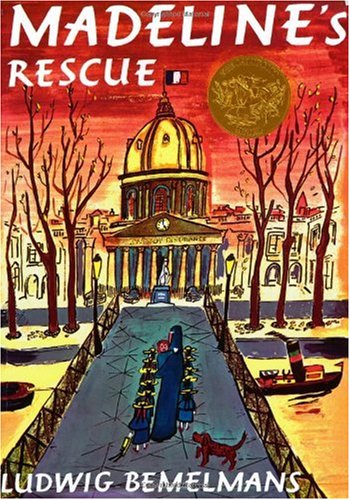1938 -- Four and Twenty Blackbirds* (Robert Lawson)
A collection of nursery rhymes including "The Old Gray Goose", "Poor Lady Dumpling" and "Little Red Hen".
1940 -- Abraham Lincoln (Ingri & Edgar Parin d'Aulaire)
"America was at a crossroads in 1939 as they debated whether or not to join the Allies in their battle against Hitler's relentless march across Europe. As European immigrants, the d'Aulaires felt keenly the importance of standing up against injustice, and saw in Lincoln the archetypal American hero as he stood against the injustice of slavery."

1942 -- Make Way for Ducklings (Robert McCloskey)
An art student sits in the Boston Public Gardens and sketches the birds he sees each morning on the way to art school. The family of ducks stops traffic and a police officer has to intervene. For more information, visit "Make Way for Ducklings" at http://alinefromlinda.blogspot.ca/2013/06/june-30.html.
1950 -- Bartholomew & the Oobleck* (Dr. Seuss)
A prose work about Bartholomew who must rescue his kingdom from a sticky substance called "oobleck". Theodor Geisel's inspiration for the story came while he was stationed in Belgium during the Second World War and a fellow soldier said: "Rain, always rain. Why can't we have something different for a change?"
1954 -- Madeline's Rescue (Ludwig Bemelmans)
Madeline falls into the Seine River and is rescued by a dog whom she brings back to the convent. The girls fight over the dog's attention. Later the dog gives birth to eleven pups, making more than enough hound to go around.

1963 -- The Snowy Day (Ezra Jack Keats)
A boy named Peter explores the neighbourhood after the first snowfall. The author was inspired by a photography in Life Magazine.
1964 -- Where the Wild Things Are (Maurice Sendak)
A boy named Max wreaks havoc in his household and is sent to bed without his supper. Max's bedroom is transformed into a jungle and he sails to an island inhabited by the "wild things". Max intimidates them and is hailed as their leader. He returns home where a hot supper is waiting for him.
1967 -- Sam, Bangs & Moonshine (Evaline Ness)
Sam is a motherless child of a fisherman who has a cat named Bangs. She likes to make up stories, like the one about her mother being a mermaid that Bangs can talk to. Sam's father warns her that her tales are "moonshine" and will one day get her in trouble. A little boy named Thomas sets out to find Sam's "mermaid" mother and gets lost, along with Bangs the cat. Fortunately, they are found but Sam has learned her lesson.

1982 -- Jumanji (Chris Van Allsburg)
Jumanji, a Zulu word meaning "many effects", is about a board game that implements real animals and other jungle elements. Chris Van Allsburg later went on to write The Polar Express.
1984 -- The Glorious Flight: Across the Channel with Louis Bleriot (Alice & Martin Provensen)
Frenchman Louis Bleriot sets out to build a flying machine that can cross the English Channel, almost 20 years before Charles' Lindbergh's infamous flight across the Atlantic Ocean.
1986 -- The Polar Express (Chris Van Allsburg)
A little boy questions the existence of Santa Claus until he takes a train trip to the North Pole and sees him with his own eyes.

1994 -- Peppe The Lamplighter* (Ted Lewin)
Young Peppe becomes a lamplighter in turn of the century New York City to help support his family.
1996 -- Zin! Zin! Zin! a Violin* (Lloyd Moss)
Filled with rhythm, this book introduces ten musical instruments and their sounds.

1999 -- Snowflake Bentley (Mary Azarian)
A young boy's parents give him a microscope for his birthday, which he uses to photograph snowflakes, each one a unique design. For more information, read my post "The Snowflake Man" at http://alinefromlinda.blogspot.ca/2013/01/january-2.html.

2000 -- Joseph Had a Little Overcoat (Simms Taback)
Based on a 40 something Jewish farmer with a colourful, striped overcoat.
2002 -- Martin's Big Words: The Life of Dr. Martin Luther King Junior* (Bryan Collier)
The immortal words of Dr. Martin Luther King are woven into this tale of the Civil Rights leader's life.

2008 -- Henry's Freedom Box: A True Story of the Underground Railroad* (Kadir Nelson)
Child slave Henry is put into a box and shipped (upside down) across the Mason Dixon Line to freedom.
2008 -- The Wall: Growing Up Behind the Iron Curtain* (Peter Sis)
This story is about an obedient child in Communist Czechoslovakia who grows into a questioning teenager amidst the Prague Revolution of 1968.
2015 -- The Right Word: Roget & his Thesaurus* (Jen Bryant)
Peter Roget loved books and words. He made list after list, eventually producing one of the most important reference books of all time.

For more information, visit http://www.ala.org/alsc/awardsgrants/bookmedia/caldecottmedal/caldecottmedal.
No comments:
Post a Comment